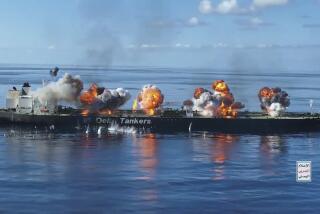Navy Escorts 2 Tankers Into Persian Gulf
- Share via
KUWAIT — A naval convoy of three U.S. warships and two “reflagged” Kuwaiti oil tankers steamed through the Strait of Hormuz on Wednesday and entered the war-plagued Persian Gulf without interference from Iran.
As the convoy cleared its first hurdle, Iran stepped up its criticism of the U.N. Security Council for demanding a cease-fire in the almost seven-year-long war between Iran and Iraq. But the Tehran government gave no sign that it would be the first to violate the truce.
The five-ship American convoy, which the Pentagon code-named Operation Earnest Will, set off from the Gulf of Oman and sailed through the strategic strait at midday.
Silkworm Missile Sites
With the cruiser Fox in the vanguard, the warships herded the two Kuwaiti tankers safely through the strait and past several sites that the Iranians have prepared for deployment of Silkworm ground-to-ship missiles obtained from China.
The destroyer Kidd and the frigate Crommelin were positioned between the tankers and the Iranian shore during the passage through the strait.
Sailors aboard the Navy vessels were kept at battle stations, the highest state of alert, during the passage, and shipping officials said the escorts broadcast warnings to other shipping to remain at least 10,000 yards away.
Called by some the “chokepoint of the Middle East,” the Strait of Hormuz at its narrowest point is only 24 miles wide, and ships passing through are less than 15 miles from Iranian territory.
The two tankers, the 401,000-ton Bridgeton and the 46,000-ton Gas Prince, flew their new American flags, which were hoisted Tuesday to mark the official re-registration of the ships in the United States.
In Washington, Pentagon spokesman Robert B. Sims said the convoy was traveling at 16 knots--the top speed of the tankers. He said that at this pace, the vessels would reach their destination, the Al Ahmadi oil complex just off Kuwait, at about noon local time on Friday.
He said that as the ships passed through the Strait of Hormuz, there was no sign of “significant” Silkworm activity. Nor, he said, was there any indication that the missiles had been deployed.
“We noted no hostile intent on the part of any ships or aircraft,” he said, and Iranian forces conducted only “normal patrol activity,” involving boats and airplanes.
After the convoy passed beyond the approximately 50-mile range of the missiles, Sims said, “We’re relieved that they’re out of the Silkworm envelope.”
The day’s only commotion came when a chartered helicopter carrying journalists approached the Kidd and was warned away. When it continued on course, flying about 1,000 yards from the ship, the Kidd fired a warning flare, and the helicopter turned away.
“The only action taken by us was to warn off boats and helicopters,” most of which carried reporters and camera crews, Sims said.
The protection given the tankers, he said, included “sufficient aircraft” from the aircraft carrier Constellation, which is operating outside the Persian Gulf. He would not specify how many aircraft were involved, but he said there were enough to handle a threat from ships or other airplanes.
The convoy’s commander, Navy Capt. David P. Yonkers, told reporters aboard the Kidd that the convoy will remain outside an exclusion zone declared by Iran along its half of the gulf.
“We may come close at one or two areas, but it is not our intention to cross that line,” Yonkers said, according to a dispatch filed by a pool of Pentagon reporters from the ship.
In addition to the Silkworm missile sites, the ships faced the potential danger of attack from a fleet of small speedboats that Iranian Revolutionary Guards have equipped as gunboats. The boats operate out of small islands along the Iranian coastline.
Presenting perhaps an even greater danger were seabed mines that have been planted in the 25-mile-long channel leading to the Al Ahmadi complex.
U.S. Navy “mine countermeasures” experts removed eight mines from the channel Tuesday with Kuwaiti and Saudi assistance. Two Saudi minesweepers were said to be making repeated sweeps of the channel, but diplomats in the region acknowledge the possibility that Iran might plant new mines at the last minute.
“I’m not really concerned until we get up to that area where we know they’ve mined before,” said Capt. William W. Mathis of the Fox.
“Will they go out and mine in preparation for this? I hope not,” Mathis said, according to the pool’s dispatch.
Mathis said that because of the proliferation of shipping in the gulf, he was maintaining eight lookouts aboard his ship. On many Navy ships, two lookouts are considered standard at sea.
“You can’t lie to an eyeball,” the captain said. “You can lie to radar.”
The U.N. Security Council approved a resolution Monday night calling for a cease-fire in the Persian Gulf War and threatening sanctions against either side that fails to comply. Even though Iran has expressed displeasure with the resolution, Western diplomats expect it to keep Iran from attacking the ships.
Iraq has responded positively to the U.N. action, and an emergency session of the Iranian Parliament was held Wednesday night to prepare Iran’s formal reply.
If Iraq, as expected, adheres to a truce in the so-called tanker war, Iran is widely expected to follow suit, in part because a lull in the gulf hostilities benefits Iran by allowing it to export more oil and thus earn more hard currency to buy arms.
Despite such pragmatic considerations, the Iranian leadership has condemned the U.N. action.
Times staff writer James Gerstenzang, in Washington, also contributed to this article.
More to Read
Sign up for Essential California
The most important California stories and recommendations in your inbox every morning.
You may occasionally receive promotional content from the Los Angeles Times.










